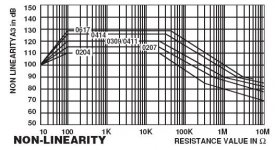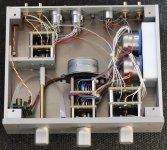A long time ago, Roederstein actually published distortion graphs of their Resista brand resistors in their catalog. What I do remember is that the 1/2 watt version had clearly lower THD (yep) than the 1/4 watt variety.
Some of the measurements can still be found.The question is what exactly where they measuring and how? Taken from a Draloric datasheet (same plant that made Resista for a while):
P.S. Current noise levels also change with size !
Attachments
john curl said:The Parasound JC-1 does exactly what I described.
Now your talking about feedback resistors in power amps, I though we were talking volume controls. Ok, so say it's 10k that's about .64W peak. I would think a 5W would be adequate, YMMV. But on that subject would you think 10 1/2W 1k's in series or 10 1/2 100k's in parallel would work too? People worry about termination effects on resistors, the current densities in the two cases are very different and then there's the different way they root sum square together and then there's all those solder joints. The mind boggles.
analog_sa said:Because they are coloured and limited in resolution? TVCs make sense only in passive preamps as they solve some of the passives deficiencies. Once you choose to go active they suddenly become a limiting factor.
Depending on a type and production batch, TVCs can be actually less coloured than active preamps or resistive attenuators.
A local guy tried TVC and now he can't go back to his AR REF 3 as according to him, it casts a vail he can't tolerate anymore.
He comissioned me to build a custom, fully featured line stage using Sowters.
Attachments
I just want to make something very clear:
When I am talking about resistor size, all that I really said is that due to instantaneous thermal changes, and perhaps other factors, all else being equal, a larger power rated resistor appears to do better.
When you simulate on your computer a new circuit, do you factor this sort of distortion into your high feedback, super low distortion designs? NO? Well, why not? And how can you do it?
Now, MRupp has shown a data sheet of the same resistors that I normally use and generally prefer. Are they perfect? NO!
I design a fair selection of audio products. Some are power amps, some are preamps, etc.
MY normal operating voltage for preamps is +/- 30V to 50V. NOW does resistor capacity start making more sense?
My power amps go up to +/- 100V. Do you know what a wimpy feedback resistor will sound like in my big amps? I do. Once, I was blindsided and the 1/2 watt Holcos in the feedback loop were replaced by a tiny, but more expensive resistor. What a mistake! It was the first thing that we changed, when we could.
When I am talking about resistor size, all that I really said is that due to instantaneous thermal changes, and perhaps other factors, all else being equal, a larger power rated resistor appears to do better.
When you simulate on your computer a new circuit, do you factor this sort of distortion into your high feedback, super low distortion designs? NO? Well, why not? And how can you do it?
Now, MRupp has shown a data sheet of the same resistors that I normally use and generally prefer. Are they perfect? NO!
I design a fair selection of audio products. Some are power amps, some are preamps, etc.
MY normal operating voltage for preamps is +/- 30V to 50V. NOW does resistor capacity start making more sense?
My power amps go up to +/- 100V. Do you know what a wimpy feedback resistor will sound like in my big amps? I do. Once, I was blindsided and the 1/2 watt Holcos in the feedback loop were replaced by a tiny, but more expensive resistor. What a mistake! It was the first thing that we changed, when we could.
Welcome back Joshua_G
TVC is transformer volume control.
http://www.sowter.co.uk/transformer-attenuators.php
TVC is transformer volume control.
http://www.sowter.co.uk/transformer-attenuators.php
TVC = transformer volume control.
If I remember the Resita spec sheets correctly, they talked about their resistors below a certain value being inductive and above a certain they became capacitive. I guessing that is what the wide flat portion of the graphs is.
That makes an argument for trying to use as many resistors as possible from within that range.
If I remember the Resita spec sheets correctly, they talked about their resistors below a certain value being inductive and above a certain they became capacitive. I guessing that is what the wide flat portion of the graphs is.
That makes an argument for trying to use as many resistors as possible from within that range.
Steve Dunlap said:TVC = transformer volume control.
If I remember the Resita spec sheets correctly, they talked about their resistors below a certain value being inductive and above a certain they became capacitive. I guessing that is what the wide flat portion of the graphs is.
That makes an argument for trying to use as many resistors as possible from within that range.
What is the safe range?
Peter Daniel said:
Depending on a type and production batch, TVCs can be actually less coloured than active preamps or resistive attenuators.
The production batch dependance is certainly annoying; sadly all my conclusions are based on a single sample. I thought it was suspicious that everyone else adores them...
Btw, your creation looks better built and more expensive than a Blowtorch 🙂
And has a remote control that does not compromise performance 😉
OTOH, those Shallco switches are so unfriendly, not only in attaching the wires, but also the switching action "feel" leaves much to desire comparing for instance to Seiden.
IMO, the last available units of TX102 before they shut OEM availability were the best. Also, the original wire seemed to sound better than upgraded from Bentaudio.
OTOH, those Shallco switches are so unfriendly, not only in attaching the wires, but also the switching action "feel" leaves much to desire comparing for instance to Seiden.
IMO, the last available units of TX102 before they shut OEM availability were the best. Also, the original wire seemed to sound better than upgraded from Bentaudio.
Peter, have you tried changing the springs in the Shallcos? Won't make it a Seiden, but it's a help.
Joshua_G said:
What is the safe range?
It has been a long time since I looked at their spec sheets. I'm sure I still have them in a file cabinet somewhere. I see if I can find them.
As I recall, the "safe" range was from 470 ohms to about 20K. It varied between the different power ratings some.
I cant say if this is true of other brands.
pooge said:Peter, have you tried changing the springs in the Shallcos? Won't make it a Seiden, but it's a help.
Yes, I changed the springs and it's easier to turn, but positions are not well defined now by clicking action.
analog_sa said:Hi Peter. How would you compare the result to a standard ladder or shunt with a nice switch?
I never had a chance to compare them side by side, but I imagine that a good switch would be better than relays.
My views on attenuators are constantly changing; I guess the perfect attenuator is defined by particular needs. I find myself most of the time using no more than 10dB range of volume adjustement, and more than often it does not depend on my actual preference but on how the recordings are made: 6dB differences are quite common from disc to disc and I don't even mention vinyl.
So presently, my idea of the most cost efficcient, practical and least compromised attenuator would be 6 position switch and 7 resistors in series forming 10k voltage devider (or whatever other resistance is preferred), the attenuation range would cover 10dB's in 2 dB steps (or 15dBs in 3dB steps) of most common settings for my usual listening environment.
That purist attenuator could be always bypassed with a regular pot for background music or party volume blasting 😉
scott wurcer said:
That's the point bear he measures it. I've known dozens of these guys outside of audio, good solid engineering often self taught. It's ONLY in audio that this stuff turns up.
Yes, Scott, I agree - he measures it.
The idea remains constant though.
And, the fact of the matter is that ultrasound is a fairly crude and imprecise system in many regards. So, I suspect that if it became as "imprecise" (wink-wink) as is audio that one would start to see the same sorts of things taking place as what we are talking about.
_-_-bear
Scotts Stuff
Hello Scott
What DAC to you plan to use after this DSP.
By the way what speakers to you use for best musical sound ( your reference)
Regards
Arthur
scott wurcer said:
Thank's for the offer but I'm moving all digital. Double precision floating point math has a -300dB noise floor.
Hello Scott
What DAC to you plan to use after this DSP.
By the way what speakers to you use for best musical sound ( your reference)
Regards
Arthur
Hi John
Sorry, you are right, I miss read your post I thought we were discussing the volume control.
Cheers
Stinius
Sorry, you are right, I miss read your post I thought we were discussing the volume control.
Cheers
Stinius
- Status
- Not open for further replies.
- Home
- Amplifiers
- Solid State
- John Curl's Blowtorch preamplifier

